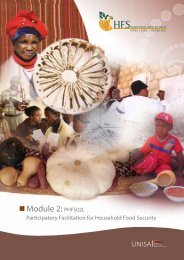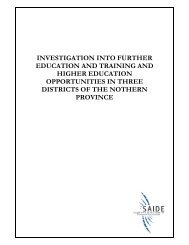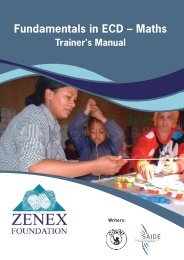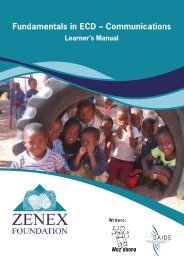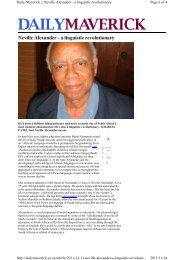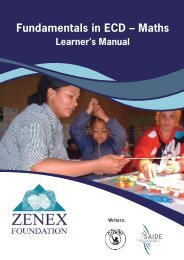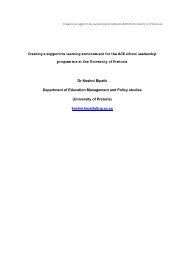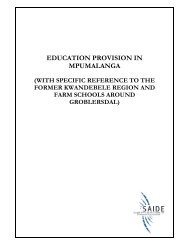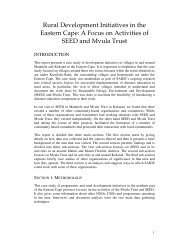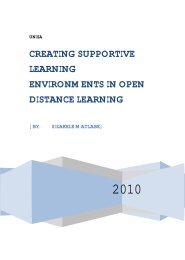The University of Cape Coast Experience - South African Institute for ...
The University of Cape Coast Experience - South African Institute for ...
The University of Cape Coast Experience - South African Institute for ...
You also want an ePaper? Increase the reach of your titles
YUMPU automatically turns print PDFs into web optimized ePapers that Google loves.
We are submitting the following contribution to the Programme Committee <strong>for</strong><br />
consideration <strong>for</strong> presentation at the conference to be held at the North-West <strong>University</strong>,<br />
Potchefstroom Campus<br />
Title <strong>of</strong> Presentation:<br />
Creating Supportive Learning Environments<br />
<strong>for</strong> Quality Distance Education Programmes.<br />
<strong>The</strong> <strong>University</strong> Of <strong>Cape</strong> <strong>Coast</strong> <strong>Experience</strong><br />
Initials and Surnames <strong>of</strong> ALL authors<br />
J.Sam-Tagoe<br />
Number <strong>of</strong> words 4,293<br />
C.Akumamoah-Boateng<br />
Sub-topic <strong>of</strong> paper addresses<br />
Creating Supportive Learning Environment<br />
Details <strong>of</strong> author to whom feedback must be submitted<br />
Name<br />
Institution<br />
Josephine Sam-Tagoe (Mrs)<br />
<strong>University</strong> <strong>of</strong> <strong>Cape</strong> <strong>Coast</strong><br />
Work Telephone Number +233285402716<br />
Fax Number<br />
Cell Phone Number +233 24 4370878<br />
E-mail<br />
nsamtagoe@yahoo.com<br />
1
Abstract<br />
<strong>The</strong> study delves into the existing supportive learning environments put in place by the<br />
Centre <strong>for</strong> Continuing Education-<strong>University</strong> <strong>of</strong> <strong>Cape</strong> <strong>Coast</strong> (CCE-UCC) and how these<br />
systems impact on the students learning. <strong>The</strong> research design used <strong>for</strong> the study was<br />
the descriptive survey with the questionnaire as the research instrument. A sample <strong>of</strong><br />
580 students drawn from a population <strong>of</strong> 4,300 final year students <strong>of</strong> the distance<br />
learning wing <strong>of</strong> CCE-UCC served as respondents to the study. <strong>The</strong> quota and simple<br />
random sampling techniques were used in collecting needed data. Data was analyzed<br />
using frequency distribution and percentages. <strong>The</strong> study revealed that distance<br />
education students <strong>of</strong> UCC enjoy supportive learning environments such as facilitation<br />
by course tutors, face-to-face sessions, already prepared print modules and services<br />
rendered by course coordinators and Regional Resident Tutors. <strong>The</strong> study also<br />
revealed that students want Online, Tele and audio conferencing as well as teleseminar<br />
facilities to be added to the existing support systems at CCE-UCC. It is recommended<br />
that the creation <strong>of</strong> supportive learning environments <strong>for</strong> distance education students<br />
should be an integral part <strong>of</strong> the programme.<br />
Background to the study<br />
<strong>The</strong> provision <strong>of</strong> quality education is critical to the development <strong>of</strong> a nation as it serves<br />
as a source <strong>of</strong> better life <strong>for</strong> people. It is an acceptable principle that a country’s human<br />
resource development is paramount to the country’s own development. In view <strong>of</strong> this,<br />
some countries in Africa have come to the realization <strong>of</strong> creating educational<br />
opportunities <strong>for</strong> their citizens to update and upgrade their knowledge and skills in order<br />
to per<strong>for</strong>m creditably in their work environments. In Ghana, much as people from all<br />
facets <strong>of</strong> life would like to upgrade their qualifications, the conventional educational<br />
institutions all over the country are not enough to absorb all aspiring students into the<br />
various tertiary institutions available. Year after year, it is becoming increasingly difficult<br />
<strong>for</strong> the few public universities to admit all applicants who apply <strong>for</strong> admission. For well<br />
over a decade now, the universities have not been able to <strong>of</strong>fer admission to more than<br />
40 percent <strong>of</strong> qualified applicants (SRMIS, 2009). For example, at UCC, the total<br />
applicants <strong>for</strong> the 2007/2008 academic year were about 15,000. Out <strong>of</strong> this number,<br />
2
only 4,146 (27.6%) had admission to pursue various programmes at the university. In<br />
2008/2009 academic year, the total applicants were around 13,000 and 4,319 (33%)<br />
gained admission. Similarly, during the 2009/2010 academic year the applicants were<br />
about 13,964 with only 4,216 (30.2%) gaining admission into the university (SRMIS,<br />
2010).<strong>The</strong> question is “where do the rest go In<strong>for</strong>mal discussions with students in the<br />
classroom indicate that there are several thousands <strong>of</strong> adult workers who need higher<br />
education to consolidate their positions at their work places. This trend <strong>of</strong> affairs over<br />
the years necessitated a move <strong>for</strong> the <strong>University</strong> <strong>of</strong> <strong>Cape</strong>-<strong>Coast</strong> to establish her<br />
distance learning wing which is the CCE-UCC in 1997.<br />
Distance learning is any type <strong>of</strong> instruction in which the student and instructor are<br />
separated by physical distance, which implies that the student is not in the same<br />
classroom most <strong>of</strong> the time (Wahlstrom , C.; Williams, B.K.; & Shea, P.( 2003). It is a<br />
medium <strong>of</strong> teaching and learning using modern technology so that teachers and<br />
students do not have to be together in the classroom. Honeyman & Miller (1993) added<br />
that, distance education or distance learning is a field <strong>of</strong> education that focuses on the<br />
pedagogy, technology and instructional system designs that aim to deliver education to<br />
students who are not physically “on site” in a traditional classroom or campus. It has<br />
also been described as a process to create and provide access to learning when the<br />
source <strong>of</strong> in<strong>for</strong>mation and the learners are separated by time and distance or both<br />
(Honeyman and Miller, 1993). <strong>The</strong> Cali<strong>for</strong>nia Distance Learning Project (CDLP-2005)<br />
says Distance Learning is an instructional delivery system that connects learners with<br />
educational resources. <strong>The</strong> Higher Education Opportunities Act (2009) defines Distance<br />
Education as a <strong>for</strong>mal interaction which uses one or more technologies to deliver<br />
instruction to students who are separated from the instructor. It usually incorporates<br />
technologies such as the internet, one-way and two-way transmissions through open<br />
broadcast, closed circuit cable, broadband lines, satellite or wireless communication<br />
devices, audio conferencing and video cassettes in conjunction with any <strong>of</strong> the other<br />
technologies. From the perspective <strong>of</strong> the researcher, distance education can be<br />
defined as a system <strong>of</strong> education that allows students to be “on site” as a group at<br />
certain times and “<strong>of</strong>f site” at other times.<br />
3
Distance Education at UCC<br />
<strong>The</strong>re are a wide range <strong>of</strong> opinions concerning the appropriateness <strong>of</strong> distance learning.<br />
Some support the importance <strong>of</strong> face-to-face and classroom experiences in which<br />
students learn from one another through classroom interaction. Others contend that a<br />
hybrid configuration, that is, part <strong>of</strong> the course in the classroom and part in distance<br />
learning is much better than learning that is presented exclusively through distance<br />
learning (O’ Lawrence, 2007). Twiss & O’Lawrence (2002) opine that hybrid courses<br />
are a blend <strong>of</strong> face- to- face instruction and online learning that satisfy students’ need<br />
<strong>for</strong> convenient course <strong>of</strong>fering while making use <strong>of</strong> faculty facilities and resourses.<br />
According to the CDLP, there are two types <strong>of</strong> distance education delivery systems. <strong>The</strong><br />
first is synchronous instruction which demands a simultaneous participation <strong>of</strong> all<br />
students and instructors. Whatever is being done comes <strong>of</strong>f at the same time and<br />
students are expected to get connected at the scheduled time. <strong>The</strong> second one is<br />
asynchronous instruction. This does not need the simultaneous participation <strong>of</strong> students<br />
and instructors. Students do not need to gather at the same place at the same time <strong>for</strong><br />
instructions. Instead, students can choose or select their own instructional time frame<br />
and interact with their course materials and instructors according to their schedules.<br />
<strong>The</strong> CDLP continues to say that asynchronous instruction is more flexible than<br />
synchronous instruction but then time limits are necessary to maintain focus and<br />
participation. Any distance education programme that requires that students meet<br />
physically <strong>for</strong> face- to- face sessions, write examinations and or receive any other<br />
in<strong>for</strong>mation is said to be hybrid in nature. A critical analysis <strong>of</strong> the types <strong>of</strong> distance<br />
education delivery systems above reveals that the UCC Distance Education Programme<br />
is both synchronous and asynchronous in nature. <strong>The</strong> Centre <strong>for</strong> Continuing,<br />
Education, <strong>University</strong> <strong>of</strong> <strong>Cape</strong>-<strong>Coast</strong> (CCE-UCC) has 24 study centres spread all over<br />
the ten regions <strong>of</strong> Ghana. <strong>The</strong> Centre runs both Diploma and Degree programmes as<br />
well as a Post Graduate Programme in In<strong>for</strong>mation Technology (M.Ed.-IT). <strong>The</strong> courses<br />
CCE-UCC <strong>of</strong>fers include Basic Education <strong>for</strong> teachers, Management Studies,<br />
Commerce and Marketing courses <strong>for</strong> non teachers.<br />
4
Quality Assurance in Distance Education<br />
Quality assurance and control are crucial to any educational package in the sense that<br />
it is the level <strong>of</strong> standard set by the education enterprise that will determine the level <strong>of</strong><br />
success it will attain. If high educational standards are set and maintained, the<br />
probability is that, high educational achievements and success will be attained. <strong>The</strong><br />
Centre <strong>for</strong> Continuing Education, <strong>University</strong> <strong>of</strong> <strong>Cape</strong>-<strong>Coast</strong> follows certain measures<br />
that can guarantee quality. <strong>The</strong>se include entry requirements, course content, qualified<br />
facilitators, study centers, face-to-face sessions, registration <strong>of</strong> courses, writing <strong>of</strong><br />
quizzes and examinations among others. To make sure that good materials are<br />
admitted into the programme, CCE-UCC admits students whose qualification fall within<br />
the entry requirements <strong>of</strong> the regular students. A Special Entrance Examination (SEE)<br />
is conducted <strong>for</strong> some CCE applicants as the mature students’ component <strong>of</strong> the<br />
regular system and candidates who pass the entrance examination are admitted into<br />
the programme. On course content, Pr<strong>of</strong>essors, Senior Lecturers and Lecturers <strong>of</strong> the<br />
various faculties are recruited to write print materials (modules) <strong>for</strong> learners. <strong>The</strong>se<br />
follow the course outline <strong>of</strong> the regular students, and are edited and reviewed from time<br />
to time. Qualified course facilitators are recruited to facilitate students learning during<br />
face-to-face sessions that are organized <strong>for</strong> students. <strong>The</strong> staff <strong>of</strong> the centre visit these<br />
centers to interact with students. Regional Resident Tutors (RRT’s) have been placed<br />
in the regional capitals to cater <strong>for</strong> the needs <strong>of</strong> students and <strong>of</strong>fer counselling where<br />
necessary. At the headquarters, there are co-coordinators <strong>for</strong> the various units <strong>of</strong> the<br />
centre. <strong>The</strong> units include students and course tutors affairs, assessment, examination,<br />
teaching practice, project work, research, records and dispatch. <strong>The</strong> centre organizes<br />
three quizzes in a semester and an end <strong>of</strong> semester examination <strong>for</strong> all students. Those<br />
<strong>of</strong>fering Basic Education programmes do Teaching Practice and write Research Project<br />
Work. In order to build a unifying front, the students <strong>of</strong> CCE-UCC have an association<br />
captioned, Distance Education Students Association <strong>of</strong> Ghana (DESAG) which is a<br />
component <strong>of</strong> the Students Representative Council (S R C) <strong>of</strong> the conventional<br />
students. DESAG has there<strong>for</strong>e become a channel <strong>of</strong> communication <strong>for</strong> students <strong>of</strong><br />
CCE and the university authority. At the beginning <strong>of</strong> each semester students are<br />
expected to register personally at the study centres and to collect their learning<br />
5
materials. All these bring about quality in the distance education programme in the<br />
sense that students draw on these resources to enhance the learning process.<br />
Supportive Learning Environments <strong>of</strong> CCE –UCC<br />
In creating a supportive learning environment, it is necessary to look at all the factors<br />
that impact on the development <strong>of</strong> students. Consideration should be given to the<br />
physical, intellectual and emotional aspects <strong>of</strong> the environment (Thompson and<br />
Wheeler, 2008). <strong>The</strong> distance learning environment plays a key role in the success or<br />
failure <strong>of</strong> the student. Every effective distance education programme must there<strong>for</strong>e<br />
give a serious attention to the creation <strong>of</strong> supportive learning environment <strong>for</strong> students.<br />
Reddy (1988) explains that, the objective behind setting up the student support system<br />
is to minimize the potentials <strong>for</strong> conflict and help the student to proceed with the<br />
academic work in a systematic manner to achieve success. To do this effectively, the<br />
human element <strong>of</strong> the programme must be considered.<br />
Alias and Rahman (2005) after a study in some Malaysian Universities came out to say<br />
that learners indicated a conventional view <strong>of</strong> their learning facilitators and were waiting<br />
to be taught during monthly seminars. Some <strong>of</strong> the students expressed their needs <strong>for</strong><br />
continuous human contact and the presence <strong>of</strong> a teacher figure to guide their learning.<br />
It is worth noting that distance learners may need different kinds <strong>of</strong> help. <strong>The</strong>y may<br />
need help be<strong>for</strong>e, during and after the programme. Be<strong>for</strong>e they start learning, students<br />
may be supported to recognize that they need to learn and decide what they want from<br />
the learning and how best to achieve it (Lewis and Spencer, 1986). Rowntree (1992)<br />
stated that: “these support systems need to be planned at least as rigorously as the<br />
package materials. Learners without support are most liable to delay their completion <strong>of</strong><br />
a programme or to drop out completely. <strong>The</strong>y simply have no one to turn to when they<br />
run into problems. <strong>The</strong> sad thing is that their problems would <strong>of</strong>ten have been solved by<br />
a few minutes <strong>of</strong> a supporter’s time-perhaps just enough to say “yes, <strong>of</strong> course you can<br />
take longer over the project” or you’re doing fine, everybody has trouble with that<br />
section” (Rowntree, 1992:35). <strong>The</strong> <strong>for</strong>egoing indicates that learners can run into all<br />
kinds <strong>of</strong> anxieties, problems and difficulties when trying to learn under their own steam.<br />
6
It is based on some <strong>of</strong> these frustrations and expectations that CCE-UCC has created<br />
some support system <strong>for</strong> its learners. <strong>The</strong> Centre runs face- to-face session <strong>for</strong>tnightly<br />
<strong>for</strong> each year group. During such sessions, facilitators throw more light on what<br />
students have studied. <strong>The</strong>re are student-student as well as facilitator-student<br />
interactions. CCE-UCC also supports its students by assigning members <strong>of</strong> staff to visit<br />
all the 24 centres in the country weekly. <strong>The</strong>y solve students’ problems and enlighten<br />
them on issues that may be bothering them. Another supportive learning environment<br />
created by CCE-UCC is the placement <strong>of</strong> RRT’s in all the ten regions <strong>of</strong> Ghana. <strong>The</strong><br />
RRT’s are permanently based in the Regional capitals and are expected to handle all<br />
issues pertaining to students and facilitators welfare. <strong>The</strong>y disseminate all in<strong>for</strong>mation<br />
coming from the head quarters to the public including students and act as counsellors<br />
on academic, social, and emotional issues brought out by students in the course <strong>of</strong> their<br />
studies. Study centres that are located outside the regional capitals have course<br />
coordinators who see to the week to week activities <strong>of</strong> the centers. A supportive<br />
learning environment worth mentioning is the print material or modules used by<br />
students. <strong>The</strong>se are written in an interactive style and there<strong>for</strong>e are user friendly. <strong>The</strong><br />
collection <strong>of</strong> modules at the beginning <strong>of</strong> each semester alone brings students,<br />
facilitators and CCE-UCC staff together <strong>for</strong> effective interactions. <strong>The</strong>se measures are<br />
put in place to bring quality as well as making CCE-UCC students com<strong>for</strong>table and<br />
confident in their course <strong>of</strong> study.<br />
Statement <strong>of</strong> the Problem<br />
<strong>The</strong> assumption that adult learners could be largely self sufficient may not be correct<br />
(Coldeway, 1982). In most cases, adult students are studying part time and have to<br />
accommodate their studies within the demands <strong>of</strong> their families, jobs and established<br />
social life. This implies that their role as students is one <strong>of</strong> the many other roles they<br />
play. To complicate issues, most Distance Education Learners have been away from<br />
any kind <strong>of</strong> educational environment <strong>for</strong> at least a few years, so that their study habits, if<br />
not non-existent are, at least, rusty (Reddy, 1988). When they enroll into a distance<br />
education programme, the potential <strong>for</strong> conflict between the demands <strong>of</strong> their studies<br />
and those in other areas <strong>of</strong> their lives is great. It is there<strong>for</strong>e necessary to put certain<br />
7
measures in place in order to put the students at ease as well as ensuring quality in the<br />
system. <strong>The</strong> purpose <strong>of</strong> this study is to sort out the existing supportive learning<br />
environments put in place by CCE-UCC and to find out whether students also see them<br />
as support systems. <strong>The</strong> study also finds out whether the supportive learning<br />
environments lead to quality distance education programmes and unravel new support<br />
systems that CCE-UCC should add to the existing ones <strong>for</strong> course effectiveness.<br />
In view <strong>of</strong> this, the study delves into the existing supportive learning environments that<br />
have been created by CCE-UCC and whether these supportive environments impact<br />
positively on students learning and lead to quality distance education programmes, as<br />
well as looking at the new supportive environments that can be created. <strong>The</strong> following<br />
research questions guided the study.<br />
1. How do students view the existing supportive learning environments that have<br />
been created by CCE-UCC<br />
2. How do these existing supportive learning environments impact on students<br />
learning as index to quality distance education programmes<br />
3. Which other supportive learning environments could be created to enhance and<br />
maintain the programme<br />
METHODOLOGY<br />
<strong>The</strong> descriptive survey research method was used <strong>for</strong> the study. <strong>The</strong> design was<br />
chosen due to the fact that descriptive survey enables the collection <strong>of</strong> detailed and<br />
factual in<strong>for</strong>mation which describes existing phenomenon. It justifies current conditions<br />
and practice (Ulin, P.R.,Robinson,T.E., Tally, E.F.,& McNeill, E.T. (2002).<br />
<strong>The</strong> target population <strong>of</strong> the study consisted <strong>of</strong> all students <strong>of</strong> the Centre <strong>for</strong> Continuing<br />
Education, <strong>University</strong> <strong>of</strong> <strong>Cape</strong>-<strong>Coast</strong>. <strong>The</strong> accessible population comprised 4,300 final<br />
year students <strong>of</strong> the 2009/2010 academic year group <strong>of</strong>fering Commerce, Management<br />
Studies and Basic Education programmes. <strong>The</strong> group was selected because they have<br />
been in the system <strong>for</strong> about three years and understands the system better.<br />
8
<strong>The</strong> quota and the simple random sampling techniques were used to select 610<br />
students from the accessible population. Thirty to sixty <strong>of</strong> the instruments were allocated<br />
to each study center depending on the numerical strength <strong>of</strong> the final year students in a<br />
particular study centre. <strong>The</strong> simple random sampling technique was then used to select<br />
students to respond to the instrument.<br />
<strong>The</strong> main instrument used <strong>for</strong> the study was a twelve item questionnaire designed by<br />
the researcher. It had two sections –A and B <strong>for</strong> demographic data and in<strong>for</strong>mation on<br />
supportive learning environments respectively. <strong>The</strong> items include sex and age <strong>of</strong><br />
respondents, what students consider as supportive learning environments, the impact <strong>of</strong><br />
the support systems on students learning, how students rate their per<strong>for</strong>mance in<br />
relation to the support systems put in place as well as the new support systems that<br />
should be added to the existing ones.<br />
According to Bowling (1999), the questionnaire is the best instrument <strong>for</strong> collecting data<br />
<strong>for</strong> survey research because surveys are carried out in natural settings. <strong>The</strong> reliability<br />
level <strong>of</strong> the instrument was determined using the test-retest technique. Sixty (60)<br />
students were pre-selected and the instrument was administered to them. After one<br />
week interval, the instrument was re-administered and a co-efficient <strong>of</strong> 0.82 was<br />
obtained.<br />
Copies <strong>of</strong> the questionnaires were sent through CCE-UCC staff who visits the various<br />
centres each week end. Respondents were given one week to complete the<br />
questionnaires. Out <strong>of</strong> the 610 questionnaires sent out, 595 were retrieved but only 580<br />
were properly responded to. This gave about 96% return rate. Data was analyzed using<br />
descriptive statistics in the <strong>for</strong>m <strong>of</strong> frequency distribution and percentages.<br />
9
FINDINGS AND DISCUSSIONS<br />
Supportive Learning Environments Created by CCE-UCC<br />
Table 1: Supportive Learning Environments (N=580)<br />
Learning Environments Respondents Percentage<br />
Face-to-face Sessions 180 31.0<br />
Course Facilitators 200 34.5<br />
RRT’s & Course Coord,s 120 20.7<br />
Print Modules 80 13.8<br />
Total 580 100<br />
Research Question one sought to find out from students the supportive learning<br />
environments that CCE-UCC has put in place <strong>for</strong> them to facilitate their learning. Data<br />
in Table 1 indicate that 200 (34.5%) <strong>of</strong> the students see the role played by course<br />
facilitators as a Supportive Learning Environment while 180 (31.0%) see face -to- face<br />
sessions in the same vein. One hundred and twenty (20.7%) said the services rendered<br />
by Regional Resident Tutor’s and course coordinators is supportive while the rest 80<br />
(13.8%) talked <strong>of</strong> print modules. <strong>The</strong> implication is that students see the role played by<br />
course facilitators, face-to-face sessions, and the role <strong>of</strong> Regional Resident Tutors and<br />
course co-coordinators as well as print modules as supportive learning environments.<br />
One might have thought that most students will see the print modules as a support<br />
system but rather only a few students saw it that way. Perhaps students see the print<br />
modules as a package they are entitled to. On supportive learning environments, Cain,<br />
Darrell L., Marrara, C., Pitre, Paul E. & Armour Sabrina (2003), in a study came out to<br />
say that all the respondents used <strong>for</strong> their study discussed the need <strong>for</strong> some type <strong>of</strong><br />
interaction that would assist them in getting to know each other. <strong>The</strong>y agreed that some<br />
type <strong>of</strong> person-to-person contact was essential to having enjoyable learning. In the<br />
same vein, Wright, T.M.; Marsh, G. E. & Miller, M. T.(2000) are <strong>of</strong> the view that, the<br />
amount <strong>of</strong> student interaction is likely to, improve distance learners’ educational<br />
experiences.<br />
10
<strong>The</strong> impact <strong>of</strong> Supportive Learning Environments on students’ learning leading to<br />
Quality Distance Education Programme.<br />
Table 2: Supportive Learning Environment and Quality in Distance Education<br />
(N=580)<br />
Reasons <strong>for</strong> Quality Respondents Percentage<br />
Print modules facilitate understanding 201 34.7<br />
Course facilitators explain issues 199 34.3<br />
Human touch through face-to-face 88 15.2<br />
Regional <strong>of</strong>ficers solve students 92 15.8<br />
problems<br />
Total 580 100<br />
Research Question 2 tried to find out the impact <strong>of</strong> the support systems put in place by<br />
CCE-UCC on students’ learning. In table 2, 201 (34.7%) respondents said the print<br />
modules are well illustrated and there<strong>for</strong>e lead to quality in distance learning. One<br />
hundred and ninety nine (34.3%) said course facilitators throw more light on what<br />
students learn and this goes a long way to impact positively on their academic<br />
per<strong>for</strong>mance, while 92(15.8%) said the Regional Resident Tutor’s in the regional <strong>of</strong>fices<br />
help to solve students’ problems and act as cousellors when the need arises. <strong>The</strong><br />
remaining 88(15.2%) who talked <strong>of</strong> the periodic face-to-face sessions said such<br />
sessions bring both students and staff together giving the programme a human touch.<br />
<strong>The</strong> available result indicates that the print modules, presence <strong>of</strong> course facilitators,<br />
establishment <strong>of</strong> regional <strong>of</strong>fices and organized periodic face-to-face sessions all lead to<br />
quality distance education. Belton (1994) and Garland (1992) ascertained that distance<br />
education depended heavily on efficient support systems to provide quality education<br />
that meets student needs.<br />
11
New Supportive Learning Environments that can be Created <strong>for</strong> CCE-UCC<br />
Students<br />
Table 3: New Supportive Learning Environments (N.S.L.E)<br />
N.S.L.E Respondents Percentage<br />
Online 206 35.5<br />
Teleconferencing 120 20.7<br />
Audio Conferencing 143 24.7<br />
Tele-seminar 111 19.1<br />
Total 580 100<br />
Research Question 3 sought to identify new supportive learning environments that can<br />
be added to those that exist already. Data in table 3 indicate that 206 (35.5%) <strong>of</strong><br />
respondents said online facilities should be added to the support systems, while 143<br />
(24.7%) talked <strong>of</strong> audio conferencing. Out <strong>of</strong> the remaining respondents, 120 (20.7%)<br />
talked <strong>of</strong> teleconferencing and the remaining 111(19.1%) talked <strong>of</strong> teleseminar.<br />
Available results in table 3 show that CCE-UCC students want to be connected online.<br />
<strong>The</strong>y also need audio conferencing, teleconferencing and teleseminar. Online is the<br />
condition <strong>of</strong> being connected to a net work <strong>of</strong> computers or other devices. <strong>The</strong> term is<br />
frequently used to describe someone connected to the internet. Distance learners want<br />
to access their results and other in<strong>for</strong>mation online so that they may not have to move<br />
from their homes and <strong>of</strong>fices to regional and distance study centres. Audio<br />
Conferencing refers to meetings held by people in different places using devices that<br />
allow sounds to be sent and received. It allows multiple parties to connect using<br />
devices such as phones, the computer and the Internet. If the parties involved need<br />
only to listen, then they will need only speakers but if they will talk, then they will need<br />
microphones in addition (Dye, 2003). A teleconference is video or a telephone meeting<br />
between persons remote from one another but linked by a telecommunications system.<br />
<strong>The</strong> Sci-Tech Encyclopedia says a teleseminar is unutilized <strong>for</strong> educational purposes. It<br />
is primarily one way communication to many destinations from one source. It almost<br />
always uses audio communication and may also use video and some <strong>for</strong>m <strong>of</strong> graphics.<br />
12
A means is provided <strong>for</strong> the receiving locations to ask questions <strong>of</strong> the instructor via<br />
microphones or telephone handsets.<br />
Conclusion<br />
<strong>The</strong> study is limited to the twenty four centres <strong>of</strong> CCE-UCC that have final year<br />
students. <strong>The</strong> focus is on distance education students alone and the new supportive<br />
learning environments mentioned by students were grouped under four main headings:<br />
Online, Teleconferencing, Audio conferencing and teleconferencing. <strong>The</strong> new<br />
supportive learning environments are all electronically operated. Much as these<br />
supportive systems will enhance students’ learning and access to in<strong>for</strong>mation, they may<br />
not be <strong>of</strong> benefit to all CCE-UCC Students. This is due to the fact that some <strong>of</strong> the<br />
students reside and work in very remote areas with no source <strong>of</strong> electricity at all. Others<br />
do not have access to any <strong>of</strong> the electronic gadgets that can connect them online.<br />
<strong>The</strong>re is also the problem <strong>of</strong> power fluctuation in the country which may not make it<br />
possible <strong>for</strong> students to be connected at certain times. On the other hand, if these<br />
measures are put in place, there will be a broader access to students’ involvement in<br />
university activities. It will save time and travel costs. Audio conferencing, <strong>for</strong> instance,<br />
can be used to solve a number <strong>of</strong> problems that can arise when multiple parties need to<br />
meet. People who are distant and busy do not have to sacrifice the travel time since the<br />
meeting can be conducted from a nearby phone or computer. A person who will<br />
otherwise be excluded due to a bedridden illness can participate. Money that will be<br />
needed to book a meeting place can be saved <strong>for</strong> other pressing issues. In conclusion,<br />
one can say that creating supportive learning environment <strong>for</strong> distance education<br />
learners is crucial to the success <strong>of</strong> the programme.<br />
Recommendation<br />
Creating supportive learning environments <strong>for</strong> distance education students<br />
should be an integral part <strong>of</strong> the programme.<br />
<strong>The</strong> new support systems can be introduced by using electronic gadgets that can<br />
make use <strong>of</strong> dry cell batteries such as the radio.<br />
13
Online facilities can start with students in the regional and district capitals that have<br />
access to some <strong>of</strong> the electronic gadgets needed.<br />
References<br />
Alias,Nor Aziah& Nik Suryani Nik Abdul Rahman (2005) <strong>The</strong> supportive distance<br />
learning environment: A study on the learning support needs <strong>of</strong> Malaysia 0nline<br />
learners. Selangor: Malaysia.<br />
Belton, B.(1994) A pilot study <strong>of</strong> interactions between teachers and senior students at<br />
the Brisbane school <strong>of</strong> distance education. Townsville, Queensland, Australia:<br />
Proceedings <strong>of</strong> an International Conference Held by the Rural Education Research and<br />
Development Centre. ERIC Document Reproduction Service No. ED 390 611).<br />
Bowling, A. (1999) Research methods in health investigating and health services.<br />
Buckingham: Open <strong>University</strong> Press. 119-200<br />
Cain, Darrell L., Marrara, C., Pitre Paul E.& Armour Sabrina (2003) Support Services<br />
that Matter: An exploration <strong>of</strong> the experiences and Needs <strong>of</strong> Graduate Students in a<br />
Distance Learning Environment. Journal <strong>of</strong> Distance Education 18, 1,42-56<br />
Cali<strong>for</strong>nia Distance Learning Project 2005, Adult learning activities.<br />
Country Office <strong>of</strong> Education, Cali<strong>for</strong>nia.<br />
Sacramento<br />
Coldeway, D. (1986) What does Educational Psychology Tell us about the adult learner<br />
<strong>of</strong> a distance In Daniel, J.S. & Hughes, L.J. (Eds.).Learning at a distance. N.J.: Printice<br />
Hall, Inc.<br />
Distance Education Clearinghouse (2007. Cali<strong>for</strong>nia Distance Learning Project: What is<br />
‘distance Learning Board <strong>of</strong> Regents. <strong>University</strong> <strong>of</strong> Winconsin- Extension.<br />
14
Dye, Felicia (2003)) Freelance Writing Jobs home. Write <strong>for</strong> wise GEEK (Retrieved<br />
21/7/2010 http:www.wisegeek.com/what-is-audio-conferencing.htm.)<br />
Garland M. R. (1992) Variable affecting persistence in distance education in the natural<br />
resource sciences.(Doctoral dissertation, <strong>University</strong> <strong>of</strong> British Colubia Canada)><br />
Dissertation Abstracts International. 54,06A.<br />
Honeyman & Miller 1993, Agriculture distance education: A valid alternative <strong>for</strong> higher<br />
education. Proceedings <strong>of</strong> the National Agriculture Education Research Meeting. 67-73.<br />
(Retrieved 25/6/2010.http://en.wikipedia.org/wiki/Distance_education).<br />
Lewis, R. and Spencer, D. (1988)<br />
Educational Technology.<br />
What is Open Learning London: Council <strong>of</strong><br />
O’ Lawrence, Henry 2007, An Overview <strong>of</strong> the influences <strong>of</strong> Distance Learning on Adult<br />
Learners. Journal <strong>of</strong> Education and Human Development. 1,(1) 1-9.<br />
Reddy, G.(1988) Open Universities: <strong>The</strong> Ivory Towers Thrown Open. New Delhi:<br />
Sterling Publishers Private Limited. L-10 Green Park Extension.<br />
Rowntree, Derek (1992) Exploring Open and Distance Learning. 120 Bentonville Road,<br />
London N1 9JN: Kogan Page Limited.<br />
Students Records and Management In<strong>for</strong>mation Section (SRMIS) (2009) Ghana:<br />
<strong>University</strong> <strong>of</strong> <strong>Cape</strong>-<strong>Coast</strong>.<br />
<strong>The</strong> Higher Education Opportunities Act 2009, Distance Education and Correspondence<br />
Educational manual. A publication <strong>of</strong> the Accrediting Commission <strong>for</strong> Community and<br />
Junior Colleges Western Association <strong>of</strong> Schools and Colleges.<br />
15
Thompson, N.E. & Wheeler, J.P.( 2008) Learning environment: creating and<br />
implementing a safe supportive learning environment. Journal <strong>of</strong> Family and Consumer<br />
Sciences Education 26(National Teachers Standards 2), 33-43.<br />
Ulin, P. R., Robinson T.E., Tally, E.F. & McNeill, E.T. (2002) Qualitative Methods,North<br />
Carolina: Family Health International, 1-61.<br />
Ulin, P. R., Robinson, T.E, Tally, E. F. & McNeill, E.T.(2000) Qualitative Methods, North<br />
Carolina: Family Health International. 1-61<br />
Wahlstrom, C Williams, BK & Shea, P 2003, <strong>The</strong> Successful distance learning student.<br />
Scratchgravel, Belmont, CA.<br />
Wright, T. M., Marsh, G.E. and Miller, M. T. (2000) A critical comparison <strong>of</strong> graduate<br />
students’ satisfaction in asynchronous and synchronous course instruction. Planning<br />
and Changing. 31(1/2), 107-118.<br />
16



